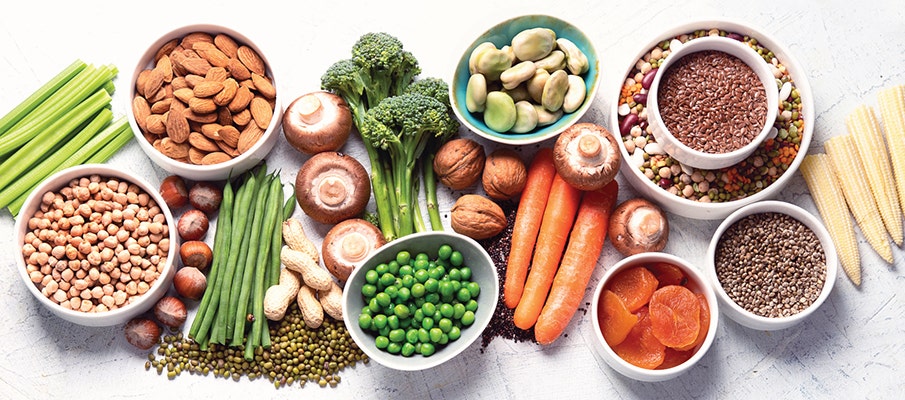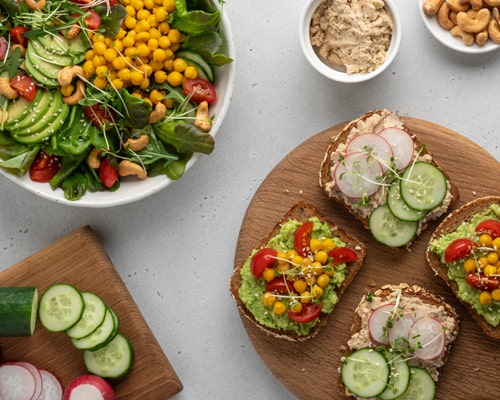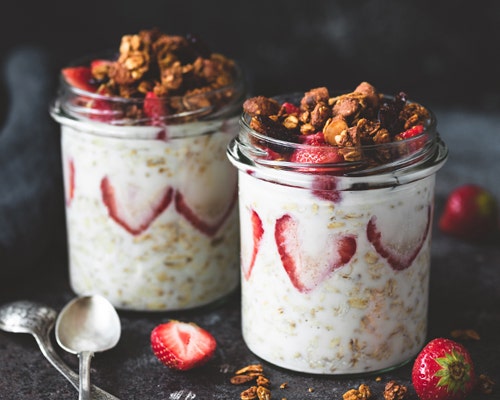Soluble vs Insoluble Fiber: What is the Difference?
- 9/28/23


Fiber is a vitally important, but unglamorous nutrient that helps your digestion stay regular. Still, fiber actually has many more benefits beyond digestive health.
There are two main types of fiber. These include soluble and insoluble, which each have their own role in digestion, cholesterol, blood sugar control, and even helping support a healthy weight. What are the different types of fiber, where can you find it, and how much do you need?
What is fiber?
Fiber is a nutrient found in plants. It is a complex carbohydrate that provides structure to plants. Interestingly, it’s the reason why corn stalks stand tall. The fiber provides the structure that helps hold them up.
Plant foods are a source of fiber. Foods high in fiber include:
- Vegetables
- Whole grains
- Fruit
- Legumes
- Beans
- Nuts
- Seeds
Fiber is not found in animal foods, dairy products, or oils, like olive or vegetable oil, even though they are made from plants.
The recommended amount of fiber per day is 25-34 grams depending on your age and sex. Unfortunately, only about 5% of the US population regularly eats enough fiber. Most Americans only eat about 17 grams of fiber per day. This means that 95% of us are lacking this important nutrient in our diets.
Soluble fiber vs. insoluble fiber
There are two main types of fiber: soluble and insoluble. Each type has a different, but important role, in our health. There is no specific amount recommended for each type of fiber. Instead, aim for the total recommended grams per day.
What is soluble fiber?
Soluble fiber is found in fruits and vegetables. Typically, soluble fiber is on the inside of the fruit or vegetable. For example, the white part of the apple or pear. Insoluble fiber is mostly in the skin or peel.
Foods high in soluble fiber include:
- Legumes and beans
- Peas
- Apples
- Avocados
- Bananas
- Brussels sprouts
- Citrus fruit
- Oats
- Barley
- Psyllium
- Chia
- Flaxseed
Soluble fiber dissolves in water, forming a type of gel in your digestive tract. The ability of soluble fiber to dissolve in water is why it has so many health benefits. The gel holds water and hydration making your stool easier to pass. It may also act as a prebiotic, serving as a food for healthy bacteria in your gut. Both of these functions help support a healthy digestive tract.
The gel created by soluble fiber and water traps certain nutrients inside. Soluble fiber helps slow down the absorption of carbohydrates, helping them slowly enter the bloodstream and preventing spikes in blood sugar after meals.
Soluble fiber hold water and helps you feel full for longer after meals. When you feel satisfied, you may eat fewer calories, which can help make it easier to maintain a healthy weight.
Additionally, soluble fiber may help support healthy cholesterol levels. Inside the digestive tract, soluble fiber traps and excretes bile during digestion. The body is forced to make new bile from existing cholesterol, using up stored cholesterol. It is believed that this process helps support normal cholesterol levels.
As you can see, soluble fiber has many benefits beyond good digestion. But what about its partner, insoluble fiber?
What is insoluble fiber?
Insoluble fiber is the opposite of soluble fiber in that it absorbs water, but does not dissolve in water.
Soluble and insoluble fiber work together to keep digestion smooth and regular. The gel created by soluble fiber helps maintain hydration in the digestive system. While the insoluble fiber adds bulk to the stool to push things along.
The bulk created by insoluble fiber provides mass for your digestive muscles to push up against, helping your bowel movements stay regular and frequent. Helping food move faster through the digestive system may also relieve uncomfortable symptoms such as gas and bloating.
Insoluble fiber is found in the skins and stalks of fruits and vegetables. Foods high in this type of fiber include:
- The skin of fruits and vegetables, such as apples, pears, or peaches
- Carrot peels
- Potato skins
- Broccoli stems or stalks
- Whole grain breads and cereals
- Wheat bran
- Oat bran
This is why it's important to eat the whole piece of fruit, including the peel. Ideally, you want to eat foods containing both soluble and insoluble fiber for the biggest benefit. Luckily, most fruits and vegetables have both.
How to eat more fiber
Rather than focusing on soluble fiber vs insoluble fiber, consider ways you can eat more fiber overall. The benefit comes from eating more high-fiber foods, which also typically offer many other nutrients. Remember that fiber is only found in plant foods.
Start slowly adding fiber to your diet. Eating too much fiber when you are not used to it can make digestive symptoms worse, resulting in more bloating, gas, cramping, constipation, or diarrhea.
Also, an increase in fiber should always be paired with more water. Insoluble fiber will absorb water. Not drinking enough while you increase your fiber intake can make constipation worse. Aim to drink at least 8 glasses of water daily to stay hydrated, especially when you are adding fiber to your diet.
Start by looking for foods that you are already eating that could be substituted for a higher fiber option. White rice can be replaced by brown or wild rice. Low-fiber cereal can be swapped with a higher-fiber option. Simply making changes to foods you already eat is the easiest way to eat more fiber.
When you are ready begin making small changes one meal at a time. For example, if you typically eat white bread at lunch, swap it out for whole grain, then wait 2-3 days before adding any other high-fiber foods. If you do not experience any discomfort, continue the process until you are getting at least the 25-34 grams you need per day.
If you are struggling to meet your daily fiber needs, our Organic Raw Fiber Powder can help. It provides 9 grams of fiber sourced from 15 raw organic superfoods. Fiber powder can be mixed into smoothies, yogurt, or juice to help effortlessly boost your fiber intake.
Eating more fiber has many benefits for your digestion and overall health. Don’t worry too much about insoluble vs. soluble fiber just try to hit the recommended intake most days of the week.
References:
-
Dietary Fiber. (2003). Food and Nutrition. https://medlineplus.gov/dietaryfiber.html
-
Current Dietary Guidelines. (n.d.). Retrieved June 26, 2023, from https://www.dietaryguidelines.gov/current-dietary-guidelines
-
Quagliani, D., & Felt-Gunderson, P. (2017). Closing America’s Fiber Intake Gap: Communication Strategies From a Food and Fiber Summit. American Journal of Lifestyle Medicine, 11(1), 80–85.
-
Guan, Z.-W., Yu, E.-Z., & Feng, Q. (2021). Soluble Dietary Fiber, One of the Most Important Nutrients for the Gut Microbiota. Molecules , 26(22). https://doi.org/10.3390/molecules26226802
-
Veronese, N., Solmi, M., Caruso, M. G., Giannelli, G., Osella, A. R., Evangelou, E., Maggi, S., Fontana, L., Stubbs, B., & Tzoulaki, I. (2018). Dietary fiber and health outcomes: an umbrella review of systematic reviews and meta-analyses. The American Journal of Clinical Nutrition, 107(3), 436–444.
-
Slavin, J. (2013). Fiber and prebiotics: mechanisms and health benefits. Nutrients, 5(4), 1417–1435.
-
Surampudi, P., Enkhmaa, B., Anuurad, E., & Berglund, L. (2016). Lipid Lowering with Soluble Dietary Fiber. Current Atherosclerosis Reports, 18(12), 75.
-
McRorie, J. W., Jr, & McKeown, N. M. (2017). Understanding the Physics of Functional Fibers in the Gastrointestinal Tract: An Evidence-Based Approach to Resolving Enduring Misconceptions about Insoluble and Soluble Fiber. Journal of the Academy of Nutrition and Dietetics, 117(2), 251–264.





